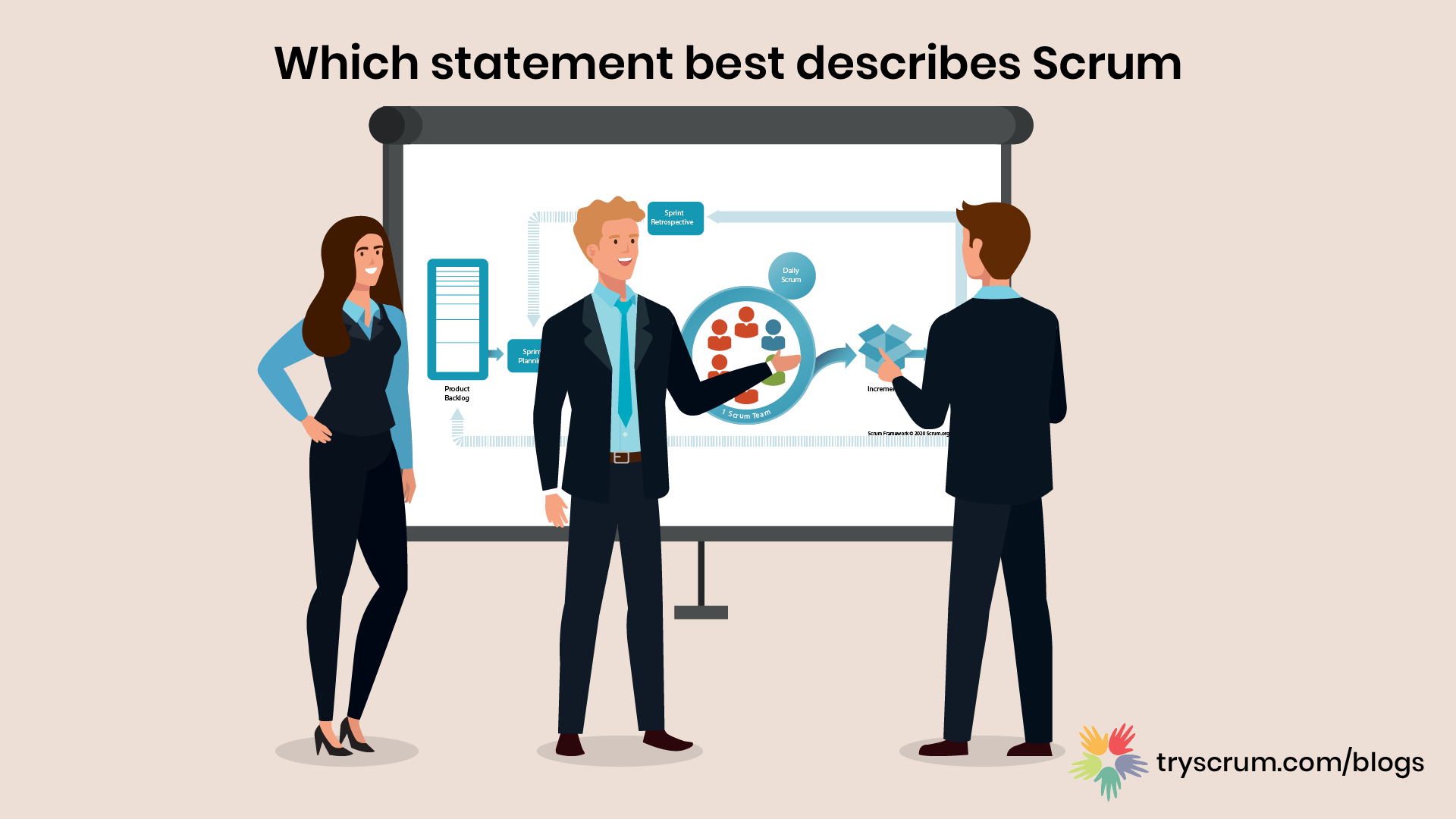
Which statement best describes Scrum
We live in a world with seven other billion people. So any new idea we come up with might have been already brought into existence. Thus it has become tough to keep up with everything in the world. That is why we brought speed into our process. If one thing guarantees you success, you will very well take it because it helps you get YOUR product out, first in the world. In this digitally transforming world, people and organisations that have embraced Business Agility will prevail and succeed. Agile is all about adaptability, quick delivery, and focuses on the customer’s needs.
I hypothesise that Scrum, the most popular Agile Framework, will be leveraged to solve complex problems through emergent solutions to validate value creation.
What is Scrum?
Let us borrow the term team-spirit for a moment. Scrum signifies the feeling of camaraderie among its team members, working towards a common goal.
Scrum in Agile development manifests a process framework that brings everyone together to create a product. “Scrum” was coined in 1986 under “The New Product Development Game”. In this article, We’ll uncover some other facts too.
Principles of Scrum
Scrum is simple to understand but challenging to master. Scrum thrives in self-organising teams that adjust with hyper transparency to create value through feedback loops. They may make mistakes and reflect on them by adapting them into their learning cycle, embracing a learning mindset and learning from experience through experimentation to succeed with Scrum.
Is Scrum a Methodology?
The answer is No. Many people call Scrum a methodology. It is a Framework that implements the three pillars of empiricism. First, Scrum replaces a codified algorithmic approach with a heuristic one, respecting people and self-management to deal with complexity. The heuristic approach that we discussed involves three pillars, which are as follows.
- Transparency
- Inspection
- Adaptation
What is Scrum Framework?
Scrum is an Agile Framework that follows an iterative and incremental approach to deliver value. It breaks down the work into tiny bits called sprints.
Each sprint outcome measures the product’s fit in the market. The incremental effort of all sprints counts to maximise the overall value. As a result, the Scrum Framework emboldens high-level participation. The below graphic represents Scrum in Action.
What is a Scrum Team?
While everybody has tried to come up with some definition for this term, we managed to simplify ours for you to understand.
Scrum Team is a small unit of people up to 10 members working towards a common goal to deliver valuable increments. They have boundaries within which people solve complex problems while productively and creatively delivering products of the highest possible value. So the bottom line is that Scrum Teams are self-managed and self-directed, generating value in a highly synergic environment.
A Scrum Team’s success depends on people embodying the values of Scrum. That is,
- Commitment: Scrum teams are committed to embodying these values. Through trust and a high level of communication between the team members, they can work towards the same goal and collaborate more effectively. In addition, they are committed to building both the right thing and things right.
- Courage: Scrum Team must have the courage to work on challenging problems. Fast failing is a benefit to Scrum Teams as this helps them uncover better ways of working and recover quickly. The scrum team should have the courage to try new things, innovate, and learn from their failures.
- Focus: Having focus is an essential aspect of a good Scrum Team. Focus increases the chances of success. For example, the product owner focuses on the product goal, and the developers focus on the sprint goal.
- Openness: The Scrum team and stakeholders agree to be open about all the work and challenges they encounter.
- Respect: Respect between team members is a must. More the respect and trust, the more likely that team will succeed.
What describes a Scrum Team?
A Scrum Team consists of three fundamental accountabilities. They are:
- Developers
- Scrum Master
- Product Owner
The Scrum team’s size typically consists of 10 or fewer people, including business analysts. testers, developers, architects etc.
Who is a Scrum Master?
Scrum Masters are true leaders who serve the Scrum Team and the larger organisation. Their key responsibility is to ensure that Scrum is used as intended to be used to maximise opportunities for feedback and minimise risks. They do this by removing obstacles that hinder the progress of their teams from achieving their desired goals—Scrum Master leverage several skills like facilitation, coaching and mentoring to serve the group and the organisation.
Who is a Product Owner?
The Product Owner is a value maximiser. Their accountability is to maximise the value of the product that results from the work of the developers. They define the product’s vision and use their skills and intellect to drive the overall direction of the product.
Why is Scrum Team becoming a part of organisations?
Scrum was initially developed for complex software development but is now being used on almost any type of team-based product work. In my view, Any organisation that wants to evolve might benefit from using Scrum Framework. In addition, organisations trying to improve the effectiveness of their value delivery should leverage Scrum.
So, Which Statement Best Describes Scrum?
In my view, it is more a mindset than a framework within which self-managing teams turn complex problems into products of the highest value.
About tryScrum





